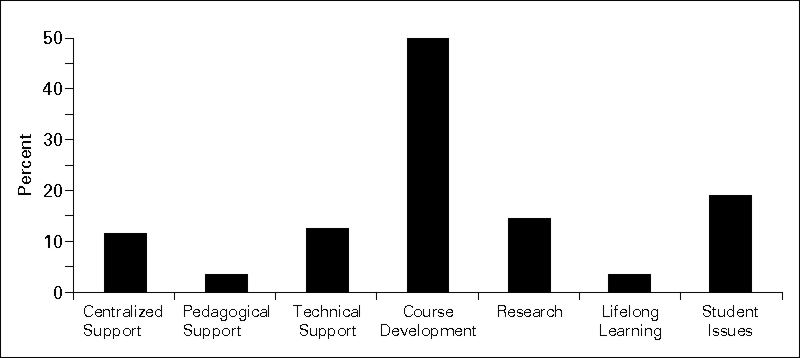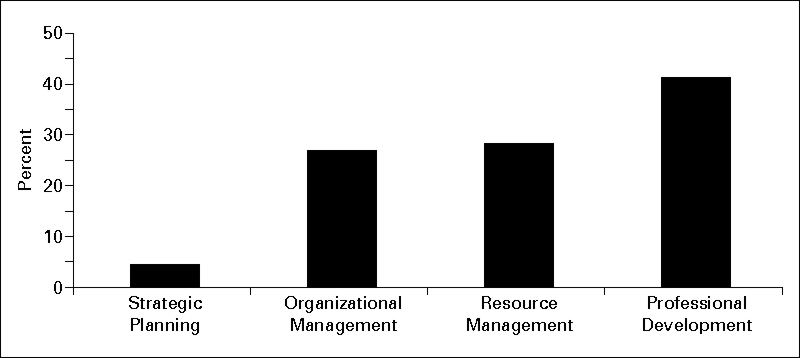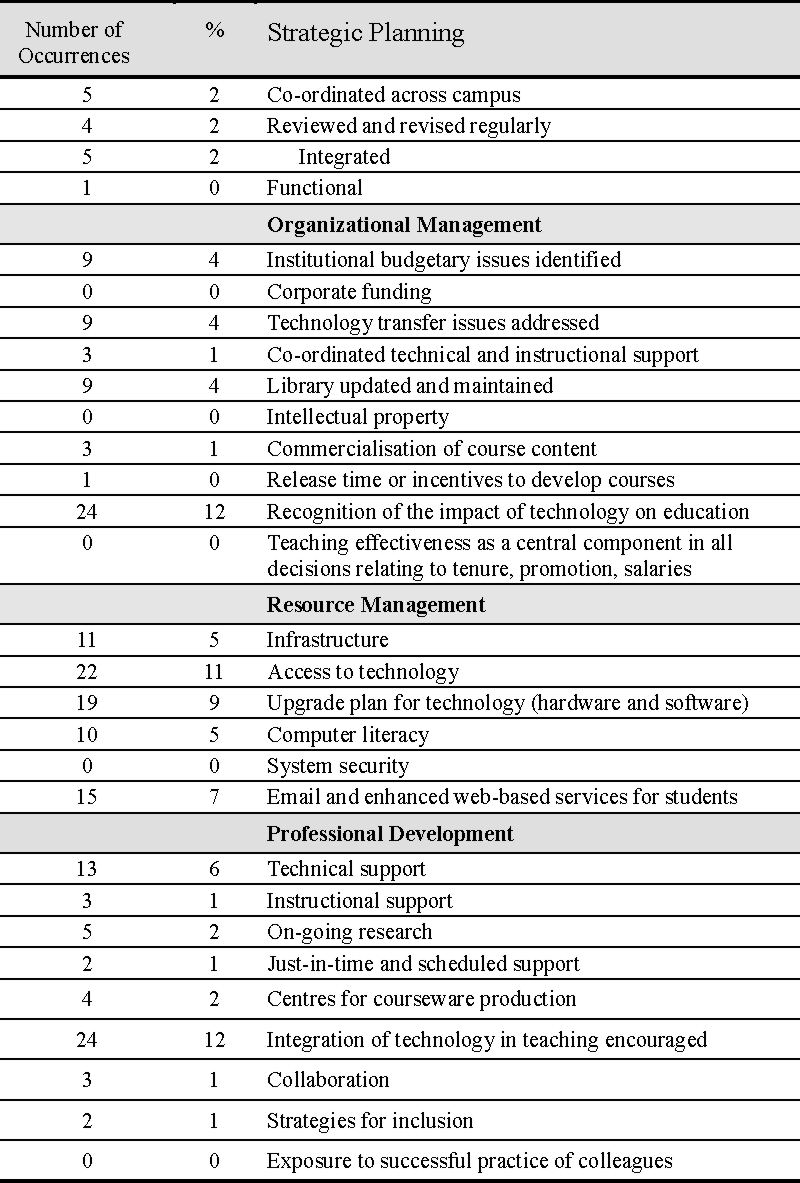
Author
Denise Stockley (stockley@post.queensu.ca) is an Educational
Developer in the Instructional Development Centre and is
cross-appointed to the Faculty of Education at Queen's University,
Canada. Correspondence concerning this article should be addressed to:
Denise Stockley, Instructional Development Centre, Queen's University,
Kingston, ON, Canada K7L 3N6.
In this study, institution-wide strategic
plans that were available online were examined in detail to determine
how educational technology was referred to in these documents. Based on
this data and the literature, a schedule of principles for supporting
the implementation of educational technology in post-secondary teaching
was developed. Institutions that are formatively evaluating local
efforts to understand and improve technologically supported instruction
can use this checklist diagnostically.
Résumé: Dans cette étude, nous
examinons en détail des plans stratégiques s'appliquant
à l'ensemble de l'institution et qui étaient disponibles
sur l'Internet, afin de déterminer comment la technologie
était référencée dans ces documents.
À partir de ces données ainsi que de la documentation,
une liste de principes a été établie afin
d'appuyer la mise en place de la technologie éducative au sein
de l'enseignement post-secondaire. Les institutions qui pratiquent
l'évaluation formative des efforts locaux pour comprendre et
améliorer l'enseignement théorique appuyé par la
technologie peuvent utiliser cette liste de contrôle pour leur
évaluation diagnostique.
Developing and implementing a strategic plan that includes educational technology is often a difficult and complex process (Ford, 1996). A strategic plan for educational technology refers to both the technological infrastructure and the manner that educational technology will be adopted in the teaching and learning environment (Bates, 2000, p. 46). The literature provides many examples of how an institution should develop a strategic plan for integrating educational technology (e.g., Benjamin et al., 1993; Bruce, 1999; Dill, 1996; Ford, 1996).
Ford (1996) suggested that the starting point for the development of an educational technology plan is to examine the overall strategic plan of the institution and how its objectives are currently being met. He was critical; however, that many institutional plans are too broad and therefore had no real meaning in driving the direction of organizational change. For example, a strategic plan that stated, "to be at the leading edge of teaching and learning," does not provide any steps or objectives to accomplish. Dill (1996) thought that the planning process was often superficial. He stated that the process of strategic planning was often used to avoid making difficult choices that may pit one department or unit against the other as they compete for limited resources.
Noblitt (1997) further cautioned that any dialogue between faculty and administration that concerns educational technology is not always civil. In spite of these criticisms, Gilbert (1996) thought that the institution needed to have a stated mission and a shared set of values among different constituencies on-campus. This vision should be within the context of what can be accomplished within the constraints of the institution (Rossner & Stockley, 1997).
In Educational Technology Planning, Bruce (1999, pp. 8-11) suggested that a strategic plan that focuses on educational technology should be connected to both the institutional mission and vision, and that the plan should fit into the overall institutional information strategy, culture, values, and history. He provided a series of recommendations for institutions involved in the planning process. These recommendations include the need for: (a) communications and advisory processes, (b) professional development and training, (c) technical and instructional support, (d) distributed learning and support for distributed learning students, (e) provision of services at regional centres, (f) technology components such as the acquisition, deployment, utilisation, replacement and disposal of the educational technology components, and (g) policy considerations such as copyright and intellectual property appropriate usage, resource provisioning, and protection of privacy.
Noblitt (1997) added that a timetable should be created to manage expectations. Planning and priority setting should be a public institution-wide process so that individuals have the opportunity to respond to concerns before the plan is finalised (Benjamin et al., 1993, p. 44). The timeline should include opportunities for the institutional community to provide feedback and to develop a shared sense of what is involved in creating the plan (Noblitt, 1997). Ford (1996) expressed further concern that most plans have not been fully evaluated to determine whether the objectives have been met. To ensure that the plan does not become a static document, it is important to identify who is responsible for the plan and for updating it (Bruce, 1999, p. 24). Stoffle (1996) cautioned that it takes five to ten years to realistically make changes to both the culture and climate of an institution. The above literature suggests that strategic planning is an on-going process that needs to take into account the institutional culture and nuances in order to move towards implementation.
When trying to create an environment that is supportive of educational technology, issues relating to credit hour requirements, registration, classroom assignments, and equipment purchase and deployment need to be addressed (e.g., Stoffle, 1996; Twigg, 1994). For example, an antiquated registration may not allow students to register for self-paced, self-directed courses.
Rossner and Stockley (1997, pp. 334-335) provided a series of requirements that would ensure the successful implementation of the strategic plan for educational technology. These requirements include:
O'Brien (1995) recommended additional institutional issues that need to be addressed to implement strategic planning effectively. These included concerns about academic quality, workload, class-size, and access to support. He recommended that an infrastructure needed to be developed for distributed learning. This would include the co-ordination of efforts between registration, computer services, bookstore, student services, library, academic departments, and the co-ordinator of the online project.
The above literature refers to strategic plans that address specifically educational technology needs; however, the question remains how educational technology planning gets translated to an overall institution-wide strategic plan that embraces all aspects of an institution _ not just the educational technology component. The research questions for this study examined this issue, specifically addressing:
In earlier research Stockley (2002), 26 institutional members of the Association of Universities and Colleges of Canada (AUCC) were identified as having online institutional strategic plans. This earlier study indicated that only 29% of the Association of Universities and Colleges of Canada (AUCC) had publicly accessible institution-wide strategic plans available on the website. Only those institutions that had an overall strategic plan were included in this study as many institutions had multiple educational technology plans that were departmentally-based and did not reflect the overall mission of the institutions. Several institutions had posted an earlier plan and a revised plan; for the purposes of this study, only the revised plan was examined. Institutions with online institutional strategic plans include:
Institutional strategic plans were downloaded and printed, due to the transient nature of the web, as there was a concern that these plans might not remain available online for further analysis. Each plan was read in print form and instances of educational technology were highlighted. The plans were re-examined on the websites using the search term "technology" or "technologie" to ensure that all instances were included. Only those instances of technology that were explicit in the plan were included in this study. Initial demographics were collected to determine whether regional disparities existed, whether size of student body affected whether an institution had a plan, and the overall number of references to educational technology within the plans.
The first level of analysis examined the number of instances in the institution-wide strategic plans that related to the four areas examined throughout this research: strategic planning, organizational management, resource management, and professional development.
The second level of analysis included the development of a literature-review-based checklist. This checklist, called the Schedule of Principles for Strategic Planning for Educational Technology, was created based on commonalities found in the guidelines and recommendations for development of strategic plans that included educational technology (Bates, 2000; Benjamin, et al., 1993 pp. 44-45; Ford, 1996; Bruce, 1999, pp. 8-11; Rossner & Stockley, 1997). In this study, the Schedule of Principles for Strategic Planning for Educational Technology was used diagnostically to determine if the principles found in the literature were included in the 26 institutional-wide strategic plans that were examined.
Demographically, there were no apparent regional disparities; nine
of the provinces had representation in this study. Table 1 illustrates
the availability of online institutional strategic plans by province.
Table 1.
Institutional Strategic Plans by Region

Of the 26 institutions with strategic plans, 7 had over 20,001
full-time and part-time students, 5 had between 10,001 and 20,000, 5
had between 5,001 and 10,000 and 9 institutions had fewer than 5000
students registered. This suggests that the number of students
registered full-time and part-time did not make a difference as to
whether an institution posted their strategic plans on the World Wide
Web. The number of specific references to educational technology in the
26 plans ranged from 0 to 24 occurrences, with a total of 251
references. The mean was 9.7 and the median was 12.
Twelve of the twenty-six institutions (46%) had twelve or more references towards educational technology. The institutions with fewer than 5,000 students account for 17% of the population referencing twelve or more occurrences of educational technology, institutions with 5,001-10,000 students had 25%, and institutions with more than 20,001 had 50% of the twelve or more references. The remaining 8% comprised of universities with student numbers ranging from 10,001-20,000.
Institutions that referenced the development or existence of an institutional strategic plan focussing specifically on educational technology were noted. In total, 11 of the 251 (4%) references targeted educational technology in their institutional strategic plans. Specifically, eight (31%) of the institutions mentioned the existence of a separate strategic plan that addressed educational technology within their institution-wide plan. These low percentages suggest that a strategic plan that only addressed issues surrounding educational technology was not emphasized in the final institutional wide strategic plan.
The area of organizational management included issues relating to
budget, technology transfer, library, impact of educational technology,
use of technology for media purposes, and any other administrative
references. These accounted for 69 (27%) of the 251 references to
technology in the institution-wide strategic plans. Seven (3%) of the
references related to budget, ten (4%) related to technology transfer,
thirteen (5%) referred to the library, twenty (8%) highlighted the
impact of educational technology on the university and society in
general, ten (4%) included the use of technology for recruitment and
media relations, and nine (4%) referred to administrative functions in
general. This is illustrated in Figure 1.
 Figure 1. Percentage of References: Organizational Management
Figure 1. Percentage of References: Organizational Management
Resource management focused on issues related to the network
infrastructure, hardware and software issues, labs and enhanced
classrooms, and administrative tools. Seventy (28%) of the 251
educational technology references in the institution-wide strategic
plan were related to resource management issues. Fifteen (6%) of the
references related to infrastructure, twenty-two (9%) to hardware and
software issues, seventeen (7%) to labs and enhanced classrooms, and
sixteen (6%) to administrative tools. These results are highlighted in
Figure 2.

Professional development accounted for 102 (41%) of the 251
references to the term educational technology. This section included a
wide range of professional development activities including: support,
course development, research, and issues relating to students. The need
for a centralized unit to provide support for educational technology
accounted for ten (4%) of the references to educational technology.
Pedagogical support occurred three (1%) times, in comparison to
technical support, which occurred eleven (4%) times. Research into or
relating to educational technology had thirteen (5%) occurrences.
Lifelong learning is mentioned in three (1%) instances, and student
issues in general were referred to seventeen (7%) times. In total 45
(18%) of the references to educational technology were related to
course issues. Figure 3 graphically organizes this data.
 Figure 3. Percentage of References: Professional Development
Figure 3. Percentage of References: Professional Development
Figure 4 provides a summary of the number of references to educational technology according to the four areas researched in this study. Strategic planning was referred to in 4% of the references (11 occurrences), organizational management in 27% (69 occurrences), resource management in 28% (70 occurrences), and professional development in 41% (102 occurrences).
 Figure 4. Percentage of References: Four Research Areas
Figure 4. Percentage of References: Four Research Areas
The 251 identified references to educational technology in the
institution-wide strategic plans were mapped using the Schedule of
Principles for Strategic Planning for Educational Technology. In total,
206 (82%) references to technology corresponded with the items
identified in the Schedule (see Table 2).
Table 2.
Schedule of Principles for Strategic Planning for Educational
Technology

This research provides an overview of how educational technology is referred to within institution-wide strategic plans and provides a tool, the Schedule of Principles, which can be used for diagnostic purposes. Based on this Schedule of Principles, 251 references to the use of educational technology were noted. However, less than 4% of these references targeted the existence or need for an educational technology strategic plan within the larger institution-wide plan. Given that only 4% of the references focused on strategic planning, an assumption is drawn that this was not viewed as a priority within the institution-wide strategic plans.
Of the four areas examined (strategic planning, organizational management, resource management and professional development), issues relating to course development or management were mentioned most often in the institution-wide strategic plans (18%). The next highest occurrence included items relating to hardware and software issues (9%). The least mentioned items were issues concerning pedagogical support and lifelong learning (1% respectively).
The data collected from the Schedule of Principles for Strategic Planning for Educational Technology corresponded with the initial analysis in that 12% (24) of the occurrences of educational technology in the institution-wide strategic plans related to the integration of technology in teaching. Recognition of the impact of technology was also referred to 24 (12%) of the times in the plans. These findings suggest that within the institution-wide strategic plan the importance of educational technology to the university is recognised and corresponds with the issue of the inclusion of technology in course-related activities.
However, many items that were identified by the literature review (as summarized by the Schedule of Principles) as being important to include in a strategic plan that included educational technology were not referenced in any of the online strategic plans. Specifically, issues concerning (1) intellectual property, (2) corporate funding, (3) teaching effectiveness as a central component in all decisions relating to tenure, promotion, and salaries, (4) system security, and (5) exposure to successful practices of colleagues were not reported. Each of these five issues were described as important in the literature as institutions move toward integrating educational technology. It is recommended that those embarking on the strategic planning process use the Schedule of Principles as a guide or checklist to ensure that their plan incorporates the educational technology elements identified within the Schedule. This Schedule was based on the literature reviewed on strategic planning and can be used diagnostically to evaluate local efforts and promote discussion surrounding technologically supported education.
This paper was partially supported by a grant from the Social
Sciences and Humanities Research Council of Canada.
Bates, A. W. (1996, December). The impact of technological change on open and distance learning. Keynote address presented at Queensland Open Learning Network, Brisbane, Australia.
Bates, A. W. (1997, January). Restructuring the university for technological change. Paper presented at the Carnegie Foundation for the Advancement of Teaching - What Kind of University, London, England.
Bates, A. W. (2000). Managing technological change: Strategies for college and university leaders. San Francisco: Jossey-Bass.
Benjamin, R., Carroll, S., Jacobi, M., Krop, C. & Shires. M. (1993). The redesign of governance in higher education. Santa Monica, CA: Rand's Institute on Education and Training.
Bruce, R. (1999). Educational technology planning. Victoria, BC: Centre for Curriculum, Transfer and Technology.
Dill, D. D. (1996). Academic planning and organizational design: Lessons from leading American universities. Higher Education Quarterly, 50(1), 35-53.
Ford, P. (1996). Information strategies: A UK perspective. Proceedings of the Institutional Management in Higher Education. Paris, France, 147-155.
Gilbert, S. (1996). Making the most of a slow revolution. Change, 28(2), 10-23.
Graham, P. S. (1997, March). Building the digital research library: Preservation and access at the heart of scholarship. Paper presented at the Follett Lecture Series, Leicester, England. Available: http://www.ukoln.ac.uk/services/papers/follett/graham/paper.html
Noblitt, J. S. (1997). Top-down meets bottom-up. Educom Review, 32(3) 38-43.
O'Brien, P. (1995). Are you ready for CMC? In J. Muzio, E. Rhynas, & R. Hurkens (Eds.), Leading edge training technologies (pp. 59-60). Victoria, BC: University of Victoria.
O'Toole, L. J. (1997). Implementing public innovations in network settings. Administration and Society, 29(2), 115-138.
Rossner, V., & Stockley, D. (1997). Institutional perspectives on organizing and delivering web based instruction. In B. Kahn (Ed.), Web-based instruction (pp. 333-336). Englewood Cliffs, NJ: Educational Technology Publications.
Stockley, D. (2002). Canadian strategic planning, infrastructure and professional development for technological innovation in post secondary education. Unpublished doctoral dissertation, Simon Fraser University, Burnaby, British Columbia.
Stoffle, C. J. (1996, November). The emergence of education and knowledge management as major functions of the digital library. Paper presented at the Follett Lecture Series, Cardiff, Wales. Available: http://www.ukoln.ac.uk/services/papers/follett/stoffle/paper.html
Twigg, C. A. (1994). Navigating the Transition. Educom Review, 29(6),
21-24.
© Canadian Journal of Learning and Technology